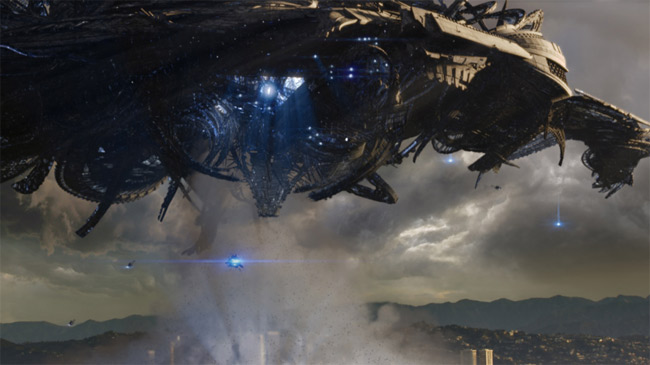Review: 'Skyline': When Aliens Land in L.A.

Aliens, typecast for years as Hollywood heavies, are back in the theaters, terrorizing the populace, wrecking a lot of urban real estate, and ingesting hapless bit-part actors.
In “Skyline,” a much-ballyhooed flick by the Strause brothers that opened Nov. 12, a weird assortment of slimy extraterrestrials from an unspecified world plummet into downtown Los Angeles like spent roman candles, and start giving humans a hard time. A lot of people probably figure that L.A. had it coming (a sentiment ironically echoed by one of the principals in the film), although in the tradition of “War of the Worlds,” the aliens are an equal opportunity enemy, and extend their evil ways to cities in other worthy countries.
The story revolves (albeit, slowly) around a small group of contentious people holed up in a penthouse apartment, kept indoors by nothing more than the gradual destruction of humanity and all of its works. Not only are they confined to quarters like bad kids banished to their rooms, this motley crew must also keep the blinds down. The invaders are outfitted with bright lights (an alien hallmark since “Close Encounters of the Third Kind”) – and like the sirens of old, their luminance can dazzle victims, luring them to destruction. These visitors from afar are just like bulked-up, air-breathing lantern fish.
The characters spend several days attempting to avoid death-by-alien, although they have neither the requisite skills nor even a helpful plot device. But you won’t care. Indeed, confronted by characters as wooden as Pinocchio, it’s a toss-up whether the audience should root for the hominids or the toad-skinned aliens.
You may not be surprised to hear that our military, bravely wielding everything from rifles to stealth aircraft, doesn’t seem able to discourage these unattractive guests. But they give it a credible shot, as it were. In one gratifying scene, they revert to a tactic that was Earth’s trump card in 1950s sci-fi films — -an atomic bomb. Alas, when the fireball fades, the nuked aliens just shake it off and come out madder than a hornet. It’s disheartening.
Back in the heyday of the Japanese creature feature, I sometimes felt sorry for Tokyo, which seemed to endure monster lizards shambling through its downtown districts on a monthly basis. Bad for business. But Los Angeles has been in disaster’s crosshairs longer, suffering giant mutant ants, killer earthquakes, tsunamis, and the unwanted attention of aliens from every sector of the galaxy.
All these extraterrestrial guests have endeavored to clear away the city, although you might cut them some slack there, simply on aesthetic grounds. Most have also targeted the citizenry. But you have to ask, why? Sometimes the aliens just want the real estate, but in “Skyline” that doesn’t seem to be the case.
Get the Space.com Newsletter
Breaking space news, the latest updates on rocket launches, skywatching events and more!
Regrettably, not much time is spent on this small matter of motivation – just what has induced these tentacled life forms to schlep hundreds of light-years to trash the ‘hood (no one actually says where they’re from, but you can bet these megafauna don’t come from oh, say, the moon).
This isn’t a trivial fault. Film critics have noted that the hero in science-fiction is the idea. The characters are merely expositors of some novel notion, some scientifically plausible fantasy.
So what’s the idea here? The aliens haven’t come for the water, nor are they interested in precious minerals or saving Earth from our environmental abuse. No, in “Skyline,” it seems the aliens are after our nervous systems – our brains and spinal cords – which they need to better themselves.
Take our brains? Futurists occasionally speculate that humanity’s destiny is to eventually upload our minds and culture into sophisticated computers. But these slimy visitors aren’t computers. They’re biological beings, obviously in possession of their own intelligence. So why would they want to suck up our brains? Especially southern California brains? In a 2006 ranking of the states by school achievement, California ranked 46 out of 50 – near the bottom. These aliens would do better to attack Vermont.
You can, of course, ignore this small plaint, and just enjoy watching earthlings battle a horde of critters that look as if they escaped from an oversized plate of frutas del mar. The visuals are darn impressive, after all. But in the end, the fact that the packaging is better than the meat is disappointing. “Skyline” is too much like a video game in which you don’t have a joystick.
Maybe the film’s producers sensed this. Several times during the movie, the characters say “I don’t believe it.” You’ll be nodding your head in agreement.
Join our Space Forums to keep talking space on the latest missions, night sky and more! And if you have a news tip, correction or comment, let us know at: community@space.com.

Seth Shostak is an astronomer at the SETI (Search for Extraterrestrial Intelligence) Institute in Mountain View, California, who places a high priority on communicating science to the public. In addition to his many academic papers, Seth has published hundreds of popular science articles, and not just for Space.com; he makes regular contributions to NBC News MACH, for example. Seth has also co-authored a college textbook on astrobiology and written three popular science books on SETI, including "Confessions of an Alien Hunter" (National Geographic, 2009). In addition, Seth ahosts the SETI Institute's weekly radio show, "Big Picture Science."









